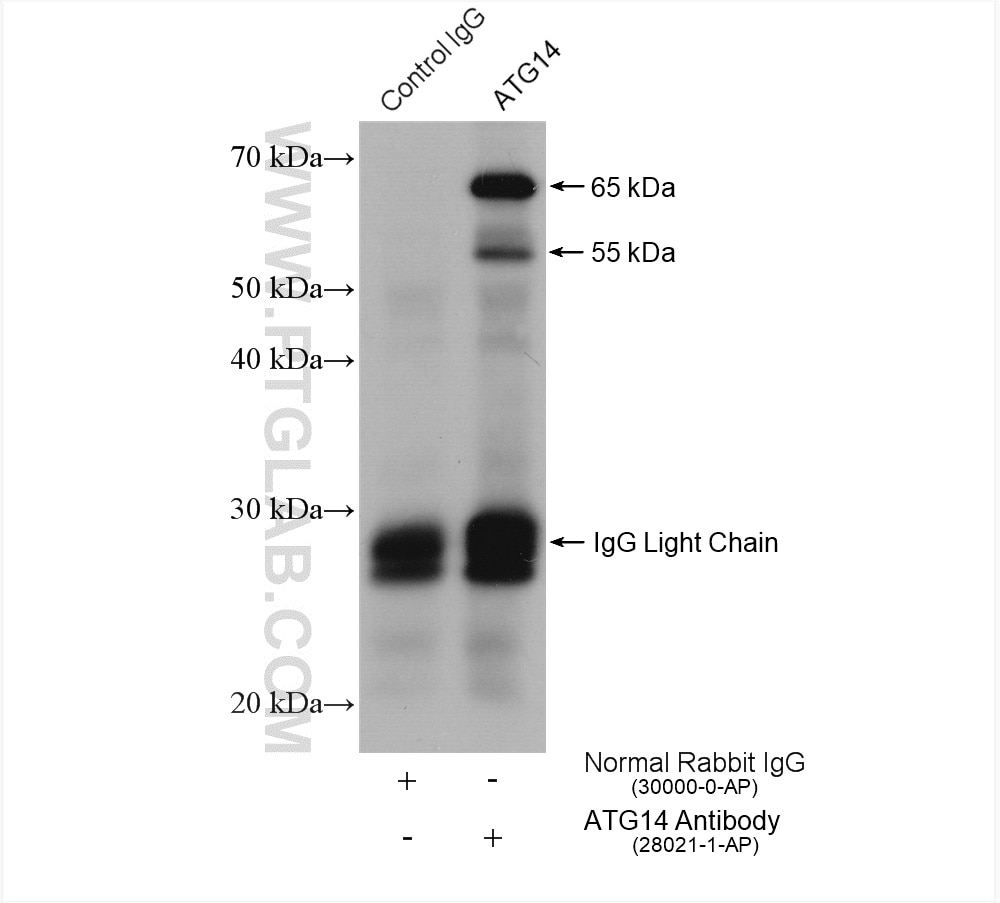Tested Applications
| Positive WB detected in | mouse brain tissue, A549 cells, rat brain tissue |
| Positive IP detected in | rat brain tissue |
| Positive IHC detected in | human liver cancer tissue Note: suggested antigen retrieval with TE buffer pH 9.0; (*) Alternatively, antigen retrieval may be performed with citrate buffer pH 6.0 |
Recommended dilution
| Application | Dilution |
|---|---|
| Western Blot (WB) | WB : 1:500-1:2000 |
| Immunoprecipitation (IP) | IP : 0.5-4.0 ug for 1.0-3.0 mg of total protein lysate |
| Immunohistochemistry (IHC) | IHC : 1:200-1:800 |
| It is recommended that this reagent should be titrated in each testing system to obtain optimal results. | |
| Sample-dependent, Check data in validation data gallery. | |
Published Applications
| WB | See 11 publications below |
| IHC | See 1 publications below |
| IP | See 1 publications below |
Product Information
28021-1-AP targets ATG14/Barkor in WB, IHC, IP, ELISA applications and shows reactivity with Human, Mouse, Rat samples.
| Tested Reactivity | Human, Mouse, Rat |
| Cited Reactivity | human, mouse |
| Host / Isotype | Rabbit / IgG |
| Class | Polyclonal |
| Type | Antibody |
| Immunogen |
CatNo: Ag27671 Product name: Recombinant human ATG14 protein Source: e coli.-derived, PET28a Tag: 6*His Domain: 1-198 aa of NM_014924 Sequence: MASPSGKGARALEAPGCGPRPLARDLVDSVDDAEGLYVAVERCPLCNTTRRRLTCAKCVQSGDFVYFDGRDRERFIDKKERLSRLKSKQEEFQKEVLKAMEGKWITDQLRWKIMSCKMRIEQLKQTICKGNEEMEKNSEGLLKTKEKNQKLYSRAQRHQEKKEKIQRHNRKLGDLVEKKTIDLRSHYERLANLRRSHI Predict reactive species |
| Full Name | KIAA0831 |
| Calculated Molecular Weight | 55 kDa |
| Observed Molecular Weight | 55 and 65 kDa |
| GenBank Accession Number | NM_014924 |
| Gene Symbol | ATG14 |
| Gene ID (NCBI) | 22863 |
| RRID | AB_2881038 |
| Conjugate | Unconjugated |
| Form | Liquid |
| Purification Method | Antigen affinity purification |
| UNIPROT ID | Q6ZNE5 |
| Storage Buffer | PBS with 0.02% sodium azide and 50% glycerol, pH 7.3. |
| Storage Conditions | Store at -20°C. Stable for one year after shipment. Aliquoting is unnecessary for -20oC storage. 20ul sizes contain 0.1% BSA. |
Background Information
ATG14 plays a critical role in autophagy which is required for both basal and inducible autophagy. It has been reported that the loss of ATG14 completely blocks autophagic fusion with lysosomes. ATG14 is associated with the location of PI3-kinase complex PI3KC3-C1 and the formation of autophagosome. Besides, BECN2 can form the BECN2:ATG14 heterodimer with ATG14. 28021-1-AP antibody recognizes the 55 kDa protein and the phosphorylated 65 kDa protein in SDS-PAGE. (PMID: 28218432, 24597603, 30894050)
Protocols
| Product Specific Protocols | |
|---|---|
| IHC protocol for ATG14/Barkor antibody 28021-1-AP | Download protocol |
| IP protocol for ATG14/Barkor antibody 28021-1-AP | Download protocol |
| WB protocol for ATG14/Barkor antibody 28021-1-AP | Download protocol |
| Standard Protocols | |
|---|---|
| Click here to view our Standard Protocols |
Publications
| Species | Application | Title |
|---|---|---|
Autophagy The mammalian actin elongation factor ENAH/MENA contributes to autophagosome formation via its actin regulatory function | ||
Cancer Lett Targeting PP2A with lomitapide suppresses colorectal tumorigenesis through the activation of AMPK/Beclin1-mediated autophagy. | ||
Ecotoxicol Environ Saf Weakened interaction of ATG14 and the SNARE complex blocks autophagosome-lysosome fusion contributes to fluoride-induced developmental neurotoxicity. | ||
Cells Cytosolic HMGB1 Mediates LPS-Induced Autophagy in Microglia by Interacting with NOD2 and Suppresses Its Proinflammatory Function | ||
Life (Basel) MiR-371a-5p Positively Associates with Hepatocellular Carcinoma Malignancy but Sensitizes Cancer Cells to Oxaliplatin by Suppressing BECN1-Dependent Autophagy | ||
Cell Mol Life Sci The cellular adaptor GULP1 interacts with ATG14 to potentiate autophagy and APP processing |
Reviews
The reviews below have been submitted by verified Proteintech customers who received an incentive for providing their feedback.
FH Balawant (Verified Customer) (12-25-2023) | I have used this antibody, and it is working great. this antibody has specific western blot band and no background.
|












